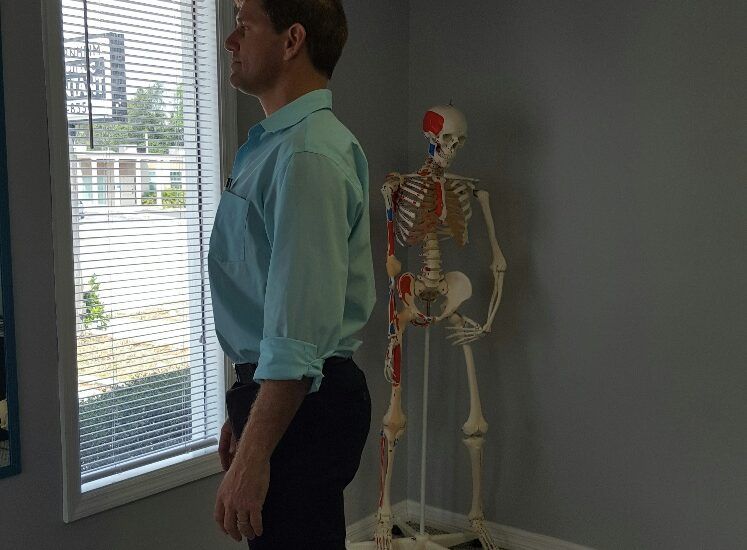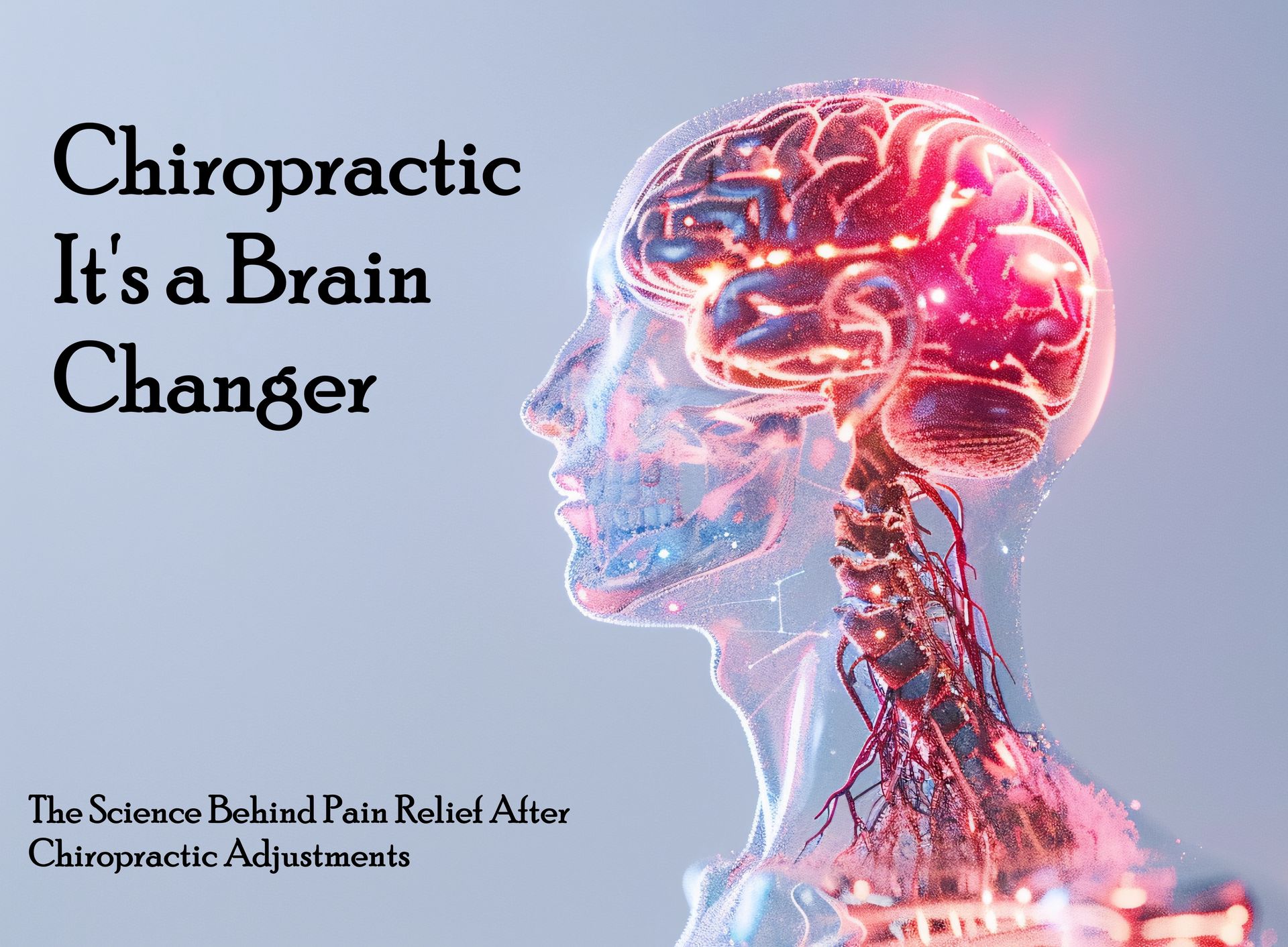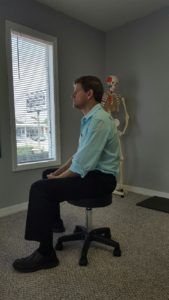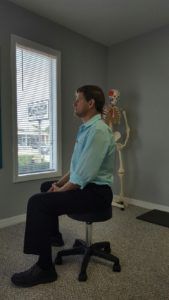Dr. Martin Standing with Bad Posture
Chiropractic and Posture!
Louise Blankenship • June 11, 2019

Have a look around. Look at your kids, your work mates, even strangers on the street. Look in the mirror. What do you notice? Are you, or the people you’re looking at, standing up straight? Do most people have good strong posture? The answer is a most resounding NO.
Most people in western societies spend an inordinate amount of time hunched over a smart phone, slouching at a work desk or even stretching the head forward to read an improperly placed computer monitor.
The majority of us have lost so much of our core strength due to a sedentary lifestyle that our ability to hold an upright posture is difficult and may even be painful. As your posture begins to degenerate you will lose your range of mobility due to tissue redevelopment and muscular contracture. Over time these unnatural stressors on the body (due to altered biomechanics or movement patterns) will cause your body to become out of alignment (what we call subluxation) and the joints/bones to wear down.
Think about this. Your head weighs about as much as a bowling ball. If you were holding a bowling ball directly over your shoulder you could probably hold it all day… But what if you stretch your arm out and held it directly in front of you. That bowling ball would feel exponentially heavier.
Now look at your kids, playing on their smart phones. What is happening to the placement of their heads?New Paragraph
Roger Sperry, Ph.D. (Nobel Prize in Physiology or Medicine 1981) discovered that 90% of the brain’s activity is used to balance your body within the gravitational field of earth. If your body is mechanically distorted, it will affect the other 10% of the brain’s activity, which controls all the other body functions such as breathing, digestion and cognition.
As your posture declines it begins with soft tissue changes and progresses through to changes in the bone. These changes are often slow and progressive. They can be corrected but the length of time they’ve been there and the degree of osseous change, will also affect the ultimate outcome.
I like to use a 3-legged stool approach to correcting these types of concerns. First is to help people realize what habits they have that have contributed to this posture and help them to stop doing them. Then if necessary we’ll adjust any region of their spine where restriction and scar tissue are preventing proper moment or neurological signaling to the brain (more on this in an upcoming blog.) And the 3rd leg of the stool is teaching spinal hygiene exercises to help correct and strengthen the spine.
Your Posture is a window to your Health. Guard it, maintain it and work on it daily.

As pet parents, we’d do anything to ensure our furry family members live their happiest, healthiest lives. We diligently schedule vet check-ups, provide nutritious food and offer endless belly rubs. But what if there was another gentle, effective tool to add to their wellness toolkit? What if subtle signs of discomfort—like hesitation on the stairs or less enthusiasm for fetch—could be addressed through a hands-on approach that supports their body's natural healing ability? Enter the world of animal chiropractic care, a holistic therapy focused on restoring mobility, alleviating pain and boosting your pet's overall quality of life. What is Animal Chiropractic Care? Just like in humans, your pet's nervous system controls everything in their body. It's the master communication network, sending signals from the brain, down the spinal cord and out to every organ and muscle. The spine acts as the protective armor for this vital highway. When vertebrae in the spine become slightly misaligned or restricted in their movement—a condition known as a subluxation—it can interfere with the flow of information along those nerves. This can lead to pain, stiffness, muscle tension, and even affect organ function. Animal chiropractic care involves a certified Doctor using their hands to apply a gentle, specific, and quick thrust to a joint to restore its normal motion. The goal is simple: to remove the interference in the nervous system, allowing the body to function and heal as it was designed to. The Tail-Wagging Benefits of an Adjustment So, what kind of positive changes might you see after your dog or cat visits a chiropractor? The benefits are surprisingly wide-ranging. 1. Improved Mobility and Pain Relief This is one of the most common reasons pet owners seek chiropractic care. Adjustments can provide significant relief for animals suffering from: • Arthritis • Hip dysplasia • Joint stiffness and general "slowing down" • Neck or back pain • Recovery from injuries or surgery By restoring proper joint mechanics, chiropractic care can reduce inflammation and pain, helping your senior dog navigate the house with ease again or encouraging your cat to leap onto their favorite perch without hesitation. 2. Enhanced Nervous System Function Since the nervous system governs everything, a well-aligned spine supports whole-body health. Proper nerve flow can improve biomechanics and coordination, which is crucial for active and athletic dogs. It can also have a positive impact on issues that might not seem related to the spine, such as certain types of incontinence or digestive problems, by ensuring the organs are getting the right signals from the brain. 3. Support for Senior Pets The golden years can be tough on a pet's body. Chiropractic care is a wonderful, non-invasive way to manage chronic pain and maintain a high quality of life for senior animals. Regular adjustments can keep them more comfortable, mobile and engaged in family life for longer. 4. Proactive Wellness and Performance You don’t have to wait for a problem to arise. For canine athletes involved in sports like agility, flyball or dock diving, regular chiropractic check-ups can help prevent injuries, improve flexibility and ensure they are performing at their peak. Think of it as essential maintenance for your high-performance companion. Signs Your Pet Might Benefit from a Visit Our pets can't tell us when they're sore. Instead, they show us through subtle changes in their behavior and movement. Keep an eye out for these signs: • Difficulty getting up from a lying position • Hesitation to jump on furniture, into the car, or go up/down stairs • Changes in posture (e.g., a roached back or sitting on one side) • Yelping or sensitivity when being touched or lifted • Limping or an unusual gait • A decline in performance or a lack of enthusiasm for play • Licking or chewing at a specific area of their body repeatedly What to Expect A visit to an animal chiropractor is a calm and gentle experience. The practitioner will start by taking a detailed history of your pet's health and lifestyle. They will then perform a thorough examination, observing your pet's gait and posture and using their hands to feel the spine and joints for areas of restriction. The adjustment itself is very quick and precise. Most animals don't even seem to notice it, and many find the process relaxing. Owners are often surprised at how gentle it is. If you've noticed your four-legged friend slowing down or showing signs of discomfort, it might be time to look beyond conventional treatments. Animal chiropractic care offers a safe, effective and holistic path to restoring movement, relieving pain and unleashing your pet's inner puppy or kitten once again. Call Family Chiropractic Plus to find out if a consultation could be the right next step for your beloved companion.

For many, a visit to the chiropractor is a reactive decision. A sudden twinge in the lower back after lifting a heavy box, a persistent crick in the neck from a long week at the desk, or headaches that just won't quit. We often wait for pain to become the primary motivator for seeking care. But what if we shifted our perspective? What if, instead of just treating problems as they arise, we could actively prevent them from happening in the first place? This is the central idea behind a growing movement in healthcare: proactive wellness. And within this model, chiropractic care is emerging as a powerful cornerstone strategy for maintaining long-term health, not just alleviating immediate pain. It's about moving from a "pain-based" model to a "wellness-based" one, where the goal is to keep you functioning at your absolute best, day in and day out. Redefining the Role of Your Chiropractor The common perception of chiropractic care often revolves around the signature "adjustment" or "manipulation " that provides relief. While these spinal manipulations are a key technique, their purpose runs much deeper than a temporary fix. Your spine is the central highway for your nervous system, which controls and coordinates every single function in your body—from muscle movement to organ function. When vertebrae in the spine are misaligned (a condition known as a subluxation), they can interfere with this critical nerve communication. A proactive approach to chiropractic care focuses on identifying and correcting these minor misalignments before they lead to pain, dysfunction, or injury. Think of it like a dental check-up or routine car maintenance; you go regularly to prevent cavities and engine failure, not just when you have a toothache or your car breaks down. The Pillars of Preventative Chiropractic Care Leveraging chiropractic as a preventative tool can have a profound impact on your quality of life. Here are the keyways regular care helps you stay ahead of health issues: 1. Improving Posture and Combating "Tech Neck" In our modern world, we spend hours hunched over computers, craning our necks to look at smartphones, and slumping on couches. This chronic poor posture puts immense strain on the muscles and ligaments of the neck and spine, leading to the ubiquitous "tech neck," tension headaches, and upper back pain. Regular chiropractic adjustments help counteract these forces, realigning the spine and retraining your body to maintain better posture naturally. This reduces daily wear and tear, leaving you with more energy and less chronic discomfort. 2. Enhancing Athletic Performance Athletes at all levels, from weekend warriors to professionals, are increasingly turning to chiropractic care to gain a competitive edge. Optimal performance relies on flawless biomechanics. A properly aligned spine ensures that the nervous system is firing messages to muscles with maximum efficiency. This can lead to improved flexibility, greater power, a better range of motion, and enhanced balance and coordination. 3. Reducing the Risk of Injury Many injuries are not the result of a single event, but rather the culmination of minor, unaddressed imbalances. A slight misalignment in the pelvis can alter your gait, putting undue stress on a knee or ankle. A stiff mid-back can force the lower back and neck to overcompensate, making them vulnerable to sprains and strains. Proactive chiropractic care is like performing a regular systems check on your body's framework. By correcting these underlying imbalances, you create a more stable and resilient structure that is far less susceptible to injury during sports, work, or daily activities. Your Proactive Toolkit: Ergonomics for the Modern Workforce Your chiropractor is your partner in wellness, but a truly proactive approach includes how you manage your body between visits. Here are some essential ergonomic tips: • Optimize Your Desk: Position your monitor so the top of the screen is at or slightly below eye level. Your chair should allow your feet to rest flat on the floor with your knees at a 90-degree angle. Keep your keyboard and mouse close to avoid over-reaching. • Stand Up Straight: If you use a standing desk, ensure it's at a height where your elbows are bent at 90 degrees. Wear supportive shoes and consider an anti-fatigue mat. • Mind Your Mobile: Instead of looking down at your phone, consciously lift it closer to eye level. • Commute Comfortably: Adjust your car seat to support your lower back's natural curve and ensure you aren't straining to reach the pedals or steering wheel. Lifestyle Tips for a Resilient Spine Beyond the office, simple daily habits can make all the difference: • Move Every 30: Set a reminder to get up, stretch, and walk around for a few minutes every half hour. • Hydrate for Your Discs: The gelatinous discs between your vertebrae are mostly water. Staying well-hydrated keeps them healthy and pliable. • Sleep Smart: Sleep on your back or side, not your stomach. Use a supportive pillow that keeps your head in a neutral position with your spine. • Lift with Your Legs: When lifting anything, bend at your knees and hips, keeping your back straight and engaging your core muscles. Take the Driver's Seat of Your Wellness Becoming a proactive patient means seeing your health as your greatest asset. It's an investment in a future with more mobility, less pain, and a higher capacity to enjoy the activities you love. Chiropractic care is not just a solution for back pain; it is a vital tool for building and maintaining a foundation of optimal wellness. If you're ready to shift from simply reacting to pain to proactively building a healthier life, consider consulting with a chiropractor. A conversation about your health goals can be the first step toward creating a personalized, preventative care plan that will serve you for years to come. We're here to support you every step of the way. Follow the link to make an appointment today https://www.familychiroplus.com/start or call and chat to our friendly staff.

If you're one of the approximately 20 million Americans living with neuropathy each year, you know firsthand how its debilitating symptoms can deeply affect your quality of life. This neurological condition, where damage to your peripheral nervous system causes a range of uncomfortable and often distressing sensations, can stem from various underlying health issues. While conventional medicine often turns to medication to manage symptoms, many people like you are seeking and finding real benefits with chiropractic care to address the root causes of neuropathic pain and discomfort. Your peripheral nervous system is vital, acting as the communication network between your brain and spinal cord (your central nervous system) and the rest of your body. When these crucial pathways are damaged or disrupted, you might experience tingling, numbness, burning, and weaknesses that are hallmarks of neuropathy. We understand that finding effective, lasting relief becomes a top priority, especially since these symptoms can worsen if not properly addressed. At Family Chiropractic Plus, we believe in a holistic and personal approach to managing your neuropathy. We focus on empowering your body's natural healing capabilities. Instead of just masking symptoms, our goal is to identify and address the potential underlying causes of your nerve dysfunction. This comprehensive strategy often includes gentle spinal adjustments, targeted therapeutic techniques, and supportive lifestyle recommendations, all designed to help improve your overall nervous system function and bring you comfort. How Our Chiropractic Care Addresses Your Neuropathy Our approach to your neuropathy is fundamentally different. We look beyond just the symptoms to understand how issues like spinal misalignments or other musculoskeletal problems might be contributing to nerve compression, inflammation, and dysfunction. This whole-body perspective aims to improve your nervous system's health by addressing the structural factors that could be irritating your nerves. A central part of our care involves gently restoring proper alignment to your spine and other joints. When vertebrae are out of place, they can put pressure on the delicate nerve roots exiting your spinal column. This pressure can interfere with normal nerve signals, leading to or worsening your neuropathic symptoms. Through precise, careful adjustments, we work to correct these misalignments, aiming to relieve that nerve compression and improve communication along your nerves. But our care for your neuropathy doesn't stop at spinal adjustments. We often incorporate other supportive therapies tailored to your needs. These might include specialized massage techniques to boost circulation to the affected areas, ultrasound therapy to help reduce inflammation, or gentle electrical stimulation to help manage pain and potentially encourage nerve function. What You Can Expect on Your Journey to Neuropathy Relief with Us Your journey with us will typically start with a comprehensive, unhurried initial consultation. This is our chance to truly listen and understand your experience – your symptoms, your medical history, and any treatments you've tried. We'll then conduct a thorough physical examination, which may include neurological tests, checking your range of motion, and gently assessing the affected areas. If needed, we might discuss imaging studies like X-rays or MRIs to get a clearer picture, especially if we suspect issues like disc herniation. Based on this complete understanding, we'll develop an individualized care plan specifically for you, focusing on your unique needs and what you hope to achieve. This plan will outline the recommended frequency of your visits, the types of adjustments and therapies we believe will help you most, and an idea of the timeline for improvement. We often begin with more frequent visits during an initial period of intensive care, then, as your symptoms improve, we'll gradually transition to less frequent maintenance care to help you sustain your progress. We promise to provide clear information about what your care will involve and what results you can reasonably expect. During your visits, you'll receive care tailored to your specific condition. Gentle spinal adjustments are usually at the heart of your treatment, where we apply precise, controlled force to specific vertebrae to help restore their proper alignment. These adjustments might be complemented by soft tissue therapies, electrical stimulation, ultrasound, or other methods chosen to reduce inflammation and support your nerve healing. We also believe in empowering you, so many of our chiropractors will guide you through specific stretches and strengthening exercises you can do at home to enhance your progress. Your active participation is key! Home care recommendations are an important part of our comprehensive approach to your neuropathy. We'll provide guidance on activities or positions to be mindful of, as well as exercises or stretches for you to do regularly. We might also discuss nutritional advice, stress management techniques, or ergonomic tips to support your overall nervous system health. By working together between your office visits, we believe you can accelerate your progress and achieve more lasting improvements in your neuropathic symptoms. We're here to support you every step of the way. Follow the link to make an appointment today https://www.familychiroplus.com/start or call and chat to our friendly staff.

How Chiropractic Care Can Help You Avoid Surgical Intervention Each year, more than 500,000 Americans undergo back surgery, a statistic that highlights the prevalence of spinal issues in our society. While surgical intervention is sometimes necessary, many patients are discovering that alternative approaches can effectively address their pain without the risks and recovery time associated with operations. Chiropractic treatment stands at the forefront of these non-invasive options, offering hope to those suffering from chronic discomfort and limited mobility. For individuals experiencing persistent neck or back pain following accidents, injuries, or due to degenerative conditions, exploring conservative treatment methods before committing to surgery makes practical sense. Chiropractic care focuses on natural healing processes, addressing the root causes of discomfort rather than merely masking symptoms. This approach not only provides relief but may also eliminate the need for surgical procedures altogether. Research increasingly supports the effectiveness of chiropractic interventions in preventing surgical outcomes. A notable study examining approximately 1,900 workers with back injuries over three years revealed striking results: among those who initially consulted surgeons, 42% eventually underwent operations, while only 1.5% of those who sought chiropractic treatment required surgery. These findings underscore the potential of chiropractic care as a viable alternative to invasive procedures. Whether you're dealing with acute pain from a recent injury or managing a chronic condition, understanding how chiropractic treatment can help prevent surgery empowers you to make informed decisions about your health journey. Let's explore the specific ways chiropractors address common issues that might otherwise lead to the operating room. Addressing Neck Pain Through Chiropractic Methods Neck discomfort represents one of the most common complaints bringing patients to chiropractic offices. This pain often stems from spinal misalignments or dysfunction that extends beyond the neck itself. Professional chiropractors recognize that cervical issues frequently connect to problems in other regions of the spine, creating a complex pattern of discomfort that requires comprehensive assessment. During initial consultations, chiropractors conduct thorough examinations to identify the underlying causes of neck pain. This diagnostic process involves evaluating posture, range of motion, spinal alignment, and sometimes imaging studies to develop a complete picture of the patient's condition. By understanding the root causes rather than focusing solely on symptoms, practitioners can develop targeted treatment strategies that address fundamental issues. Chiropractic approaches to neck pain typically incorporate various techniques tailored to individual needs. These may include gentle spinal adjustments to restore proper alignment, manual therapy to address soft tissue restrictions, and therapeutic exercises to strengthen supporting muscles. This multifaceted approach helps relieve pressure on nerves, reduce inflammation, and improve mobility without resorting to surgical intervention. Conditions responsive to chiropractic care include cervical disc injuries that don't require immediate surgery, whiplash resulting from auto accidents, facet joint sprains, and degenerative conditions affecting the neck vertebrae. Even patients who have been told surgery might be necessary often experience significant improvement through consistent chiropractic treatment, allowing them to avoid operations and their associated risks. Halting Spinal Degeneration Before Surgery Becomes Necessary The progressive nature of spinal degeneration makes early intervention crucial for preventing surgical outcomes. As individuals age, natural wear and tear affects spinal structures, potentially leading to bone spurs, decreased disc height, and compromised function. Without proper management, these changes can accelerate, eventually reaching a point where surgical intervention seems inevitable. Regular chiropractic maintenance plays a vital role in slowing this degenerative process. Through periodic adjustments, chiropractors help maintain optimal spinal alignment, reducing uneven pressure on vertebral discs and facet joints. This balanced distribution of forces allows tissues to function properly and receive adequate nutrition, supporting the body's natural healing mechanisms. Chiropractic care addresses several factors contributing to spinal degeneration. By improving joint mobility, treatments prevent prolonged compression that accelerates disc deterioration. Enhanced blood circulation delivers essential nutrients to spinal tissues while removing inflammatory waste products. Additionally, proper alignment reduces stress on supporting ligaments and muscles, creating an environment conducive to tissue health rather than breakdown. For patients already experiencing early signs of degeneration, such as occasional stiffness or minor pain, chiropractic intervention can be particularly valuable. These individuals often respond well to conservative care, experiencing improved function and reduced discomfort without resorting to surgical procedures. Even those with more advanced degeneration frequently benefit from chiropractic treatment as part of a comprehensive management approach. Treating Back Injuries Without Surgical Intervention Back injuries represent a leading cause of disability worldwide, affecting people of all ages and activity levels. Whether resulting from sudden trauma like falls or accidents, or developing gradually through repetitive strain, these injuries can severely impact quality of life. Many sufferers initially believe surgery represents their only hope for relief, unaware that chiropractic care offers effective alternatives. Chiropractors approach back injuries with a focus on comprehensive assessment and individualized treatment planning. The evaluation process identifies specific tissues involved, movement patterns affected, and contributing factors that might impede recovery. This detailed understanding allows practitioners to develop targeted interventions addressing the unique aspects of each patient's condition rather than applying generic solutions. Treatment protocols for back injuries typically combine several therapeutic approaches. Spinal adjustments restore proper alignment and movement patterns, reducing pressure on injured tissues. Spinal decompression techniques gently stretch the spine, creating negative pressure that allows herniated or bulging discs to retract. Soft tissue therapies address muscle imbalances and trigger points that contribute to pain and dysfunction. This integrated approach promotes natural healing without surgical risks. The effectiveness of chiropractic care for back injuries extends beyond immediate pain relief to address long-term function and prevention. By correcting biomechanical issues contributing to the original injury, treatments reduce the likelihood of recurrence. Patients also receive education about proper body mechanics, ergonomics, and exercises to support ongoing spinal health, empowering them to participate actively in their recovery process. Research Supporting Chiropractic as a Surgery Alternative Scientific evidence increasingly validates chiropractic care as an effective approach for preventing surgical interventions. Multiple studies demonstrate significant benefits for patients who choose conservative treatment before considering operations, particularly for common spinal conditions that frequently lead to surgery. The previously mentioned research examining workers with back injuries provides compelling evidence of chiropractic effectiveness. The dramatic difference in surgical rates—42% for those initially seeing surgeons versus just 1.5% for those consulting chiropractors—suggests that treatment approach significantly influences patient outcomes. This study, published in the respected journal Spine, represents just one example of growing research supporting non-surgical alternatives. Additional studies have examined specific conditions commonly leading to surgery. Research on lumbar disc herniations, for instance, has shown that many patients achieve substantial improvement through chiropractic care despite initially being considered surgical candidates. Similarly, investigations of spinal stenosis patients have demonstrated that conservative management often provides sufficient relief to avoid operations, even in cases with significant neurological symptoms. Cost-effectiveness analyses further support chiropractic care as a prudent first approach. When comparing overall healthcare expenditures, patients who begin with conservative treatments typically incur lower total costs, even accounting for cases that eventually require surgery. This economic advantage, combined with reduced risks and recovery time, makes chiropractic intervention an attractive option for both patients and healthcare systems seeking optimal outcomes. Comprehensive Chiropractic Approaches to Prevent Surgery Modern chiropractic care encompasses far more than the spinal adjustments commonly associated with the profession. Today's practitioners utilize diverse techniques and technologies to address complex conditions that might otherwise lead to surgical intervention, creating truly comprehensive treatment plans tailored to individual needs. Spinal manipulation remains a cornerstone of chiropractic practice, with various techniques available depending on patient needs. From gentle, low-force methods appropriate for seniors or acute conditions to more dynamic approaches for younger, athletic individuals, adjustments are customized to provide optimal benefits while ensuring patient comfort. These manipulations restore proper joint function, reduce nerve irritation, and promote natural healing processes. Beyond adjustments, chiropractors incorporate numerous complementary therapies to enhance outcomes. Therapeutic exercises strengthen supporting muscles and improve movement patterns. Soft tissue techniques address muscle imbalances and adhesions that contribute to pain. Modalities like therapeutic ultrasound and electrical stimulation reduce inflammation and accelerate tissue repair. Spinal decompression systems provide gentle stretching for disc-related conditions. This multimodal approach addresses all aspects of spinal dysfunction. Patient education represents another crucial component of comprehensive chiropractic care. By helping individuals understand their conditions and teaching self-management strategies, practitioners empower patients to participate actively in their recovery. This educational aspect extends to ergonomic recommendations, lifestyle modifications, and preventive measures that support long-term spinal health and reduce the likelihood of future problems requiring surgical intervention. Conclusion: Choosing the Conservative Path When facing spinal pain or dysfunction, exploring non-surgical options before committing to operations makes practical sense. Chiropractic care offers a conservative, evidence-supported approach that addresses the root causes of many common conditions while avoiding the risks, recovery time, and expenses associated with surgical procedures. The growing body of research supporting chiropractic effectiveness provides reassurance for those considering this path. From preventing spinal degeneration to treating acute injuries and managing chronic conditions, chiropractic interventions have demonstrated significant benefits across diverse patient populations. The dramatic difference in surgical rates between those who begin with chiropractic care versus those who initially consult surgeons speaks volumes about the potential for conservative management. For individuals experiencing neck pain, back discomfort, or reduced mobility, consulting with a qualified chiropractor represents a logical first step. Through comprehensive assessment and individualized treatment planning, these practitioners can determine whether your condition might respond to conservative care or truly require surgical intervention. In many cases, patients discover that chiropractic treatment provides the relief they seek without operations. Remember that choosing chiropractic care doesn't mean permanently ruling out surgery if truly necessary. Rather, it represents a prudent approach that explores less invasive options first, potentially saving you from unnecessary procedures while addressing your pain and dysfunction effectively. With proper chiropractic care, many patients find themselves on the path to recovery without ever needing to enter an operating room. Ready for exceptional chiropractic care? Contact Family Chiropractic Plus today at www.familychiroplus.com . Our dedicated team is committed to restoring your body's natural state of health and well-being through regular adjustments, offering comprehensive care to promote healing and support your overall health.

Nourishing your body with the right food forms the cornerstone of any effective wellness routine. Incorporating nutrient-dense options into your daily meals not only supports your physical health but also enhances your mental well-being. This comprehensive guide explores the most beneficial foods to include in your wellness regimen, offering practical suggestions for integrating these powerhouses into your everyday life. A balanced approach to nutrition involves selecting foods from various categories, ensuring you receive a full spectrum of vitamins, minerals, and other essential nutrients. By making informed choices about what goes on your plate, you create a foundation for optimal health that complements other aspects of your wellness practice. The foods outlined in this guide have been selected based on their nutritional profiles, accessibility, and versatility. Whether you're looking to revamp your entire diet or simply add a few nutritious options to your current routine, these recommendations provide a starting point for cultivating healthier eating habits that support your overall wellness goals. Remember that individual nutritional needs vary, and what works for one person may not be ideal for another. Consider consulting with a healthcare professional or registered dietitian to tailor these suggestions to your specific requirements and health conditions. Vibrant Fruits for Daily Vitality Fruits represent nature's sweet gifts, packed with essential nutrients that support numerous bodily functions. Their natural sugars provide quick energy, while their fiber content helps maintain digestive health. Including a variety of colorful fruits in your wellness routine ensures you benefit from different phytonutrients and antioxidants. Antioxidant-Rich Berries Berries stand out as nutritional powerhouses in the fruit world. Blueberries contain impressive levels of antioxidants that combat oxidative stress and support cognitive function. Their deep blue hue comes from anthocyanins, compounds linked to improved memory and reduced inflammation. Incorporate them into morning smoothies, sprinkle them over yogurt, or enjoy them as a refreshing snack on warm days. Strawberries deliver an exceptional amount of vitamin C—more than oranges by weight—while remaining low in calories and carbohydrates. These ruby-red delights support immune function, collagen production, and skin health. Their natural sweetness makes them perfect for satisfying dessert cravings without compromising your wellness goals. Raspberries and blackberries contribute significant dietary fiber, supporting gut health and promoting feelings of fullness. Their seeds contain beneficial omega-3 fatty acids, adding another dimension to their nutritional profile. Try mixing different berries together for a colorful breakfast topping or afternoon pick-me-up that delivers multiple health benefits in every bite. Versatile Tropical Fruits Bananas offer convenient nutrition in a portable package. Their potassium content supports heart health and muscle function, while vitamin B6 aids in brain development and function. The natural sugars in bananas, combined with their fiber content, provide sustained energy that makes them ideal before or after physical activity. Their creamy texture works wonderfully in smoothies, baked goods, or simply enjoyed on their own. Mangoes deliver over 20 different vitamins and minerals, including significant amounts of vitamins A and C. These tropical treasures support immune function, vision health, and skin integrity. Their vibrant flavor can transform ordinary dishes into exotic culinary experiences. Try adding diced mango to salads, salsas, or yogurt bowls for a nutritional boost with tropical flair. Pineapples contain bromelain, an enzyme mixture with anti-inflammatory properties that may help reduce swelling and promote recovery after intense physical activity. Their vitamin C content supports collagen production and immune function. The sweet-tart flavor of fresh pineapple can brighten smoothies, fruit salads, or grilled dishes, adding both nutrition and tropical appeal to your wellness routine. Everyday Fruit Essentials Apples truly embody the wisdom behind "an apple a day keeps the doctor away." Their combination of soluble and insoluble fiber supports digestive health, while their antioxidant content contributes to overall wellness. The convenience of apples makes them perfect for busy lifestyles—wash, slice, and enjoy, or pair with protein-rich nut butter for a balanced snack that supports your wellness goals. Avocados stand apart from other fruits due to their healthy fat content rather than natural sugars. These creamy green gems provide monounsaturated fats that support heart health and nutrient absorption. Their versatility extends from breakfast toast toppings to salad additions and even dessert ingredients. The combination of healthy fats, fiber, and potassium makes avocados a nutritional standout worth including regularly. Citrus fruits like oranges, grapefruits, and lemons deliver vitamin C along with unique flavonoids that support immune function and overall health. Their refreshing acidity can brighten both sweet and savory dishes, while their aromatic qualities enhance the sensory experience of eating. Keep citrus fruits on hand for quick snacking, fresh juices, or flavor-enhancing additions to water and culinary creations. Nutrient-Dense Vegetables for Optimal Health Vegetables form the backbone of any wellness-focused eating pattern, providing essential vitamins, minerals, and fiber with minimal calories. Their diverse colors indicate different phytonutrient profiles, making variety key to maximizing nutritional benefits. Incorporating vegetables from different families ensures you receive a broad spectrum of health-supporting compounds. Leafy Green Powerhouses Kale stands as a nutritional giant among leafy greens, delivering exceptional amounts of vitamins K, A, and C along with manganese and copper. Its robust fiber content supports digestive health, while its antioxidants combat oxidative stress. The slightly bitter flavor of kale becomes milder when massaged with a bit of olive oil and lemon juice, making it more approachable for those new to this nutritional powerhouse. Spinach offers impressive nutritional density with minimal calories. Its iron content supports oxygen transport throughout the body, while its vitamin K contributes to bone health. The mild flavor of spinach makes it exceptionally versatile—add it to smoothies for invisible nutrition, use it as a salad base, or wilt it into soups and stews for an easy nutritional boost to everyday meals. Swiss chard combines beautiful colored stems with nutrient-rich leaves, providing visual appeal alongside health benefits. Its betalain pigments offer antioxidant and anti-inflammatory properties, while its vitamin K, magnesium, and potassium support various bodily functions. Try sautéing Swiss chard with garlic and olive oil for a simple side dish that delivers maximum nutrition with minimal effort. Collard greens bring significant calcium to the table, supporting bone health and cellular function. Their sturdy leaves stand up well to cooking, maintaining both texture and nutritional value. Use collard leaves as natural wraps for sandwich fillings, or simmer them slowly with aromatic vegetables for a traditional side dish that honors both wellness and cultural food traditions. Cruciferous Vegetable Champions Broccoli delivers exceptional nutritional value, providing vitamin C, vitamin K, folate, and fiber in significant amounts. Its sulforaphane content, a compound activated when the vegetable is chopped or chewed, has been studied for potential cancer-fighting properties. The versatility of broccoli makes it easy to include in your wellness routine—enjoy it raw with dips, lightly steamed as a side dish, or incorporated into stir-fries and casseroles. Cauliflower has gained popularity as a versatile substitute for higher-carbohydrate foods. Beyond its adaptability, cauliflower provides vitamin C, vitamin K, and various B vitamins that support energy production and cellular function. Try roasting cauliflower with olive oil and spices for a caramelized flavor experience, or process it into "rice" for a nutrient-dense base that complements various cuisines. Brussels sprouts pack impressive nutrition into their compact form, offering vitamin K, vitamin C, and numerous antioxidants. Their fiber content supports digestive health, while their glucosinolates contribute to their distinctive flavor and potential health benefits. Roasting Brussels sprouts until caramelized transforms their flavor profile, making them appealing even to those who have previously avoided this nutritional powerhouse. Cabbage offers exceptional nutritional value at a budget-friendly price point. Its vitamin C content supports immune function, while its fiber promotes digestive health. The versatility of cabbage extends from fresh slaws to fermented preparations like sauerkraut and kimchi, which add beneficial probiotics to its already impressive nutritional profile. Incorporating cabbage in different forms ensures you receive its benefits while maintaining culinary interest. Colorful Vegetable Varieties Bell peppers in various colors contribute vitamin C, vitamin A, and numerous antioxidants to your wellness routine. Their crisp texture and sweet flavor make them enjoyable raw or cooked, while their hollow structure creates natural vessels for nutritious fillings. Red peppers contain the highest levels of antioxidants due to their extended ripening time, but all colors offer significant nutritional benefits worth including regularly. Carrots provide exceptional beta-carotene, which the body converts to vitamin A to support vision and immune function. Their natural sweetness makes them appealing across age groups, while their versatility extends from raw snacking to roasted side dishes and baked goods. The satisfying crunch of raw carrots makes them perfect for mindful eating practices that enhance the overall wellness experience. Tomatoes deliver lycopene, a powerful antioxidant that becomes more bioavailable when the vegetable is cooked. Their versatility spans from fresh salads to cooked sauces, making them easy to incorporate into various culinary traditions. Growing cherry tomatoes on a sunny windowsill can connect you with your food source while providing fresh flavor for minimal effort—a win for both nutrition and mindful eating practices. Sweet potatoes offer complex carbohydrates alongside beta-carotene, vitamin C, and potassium. Their natural sweetness satisfies cravings while providing sustained energy and numerous micronutrients. Baking sweet potatoes concentrates their flavor while preserving their nutritional value, creating a simple yet satisfying addition to meals that supports your wellness goals without complicated preparation. Protein-Rich Foods for Strength and Recovery Protein serves as the building block for tissues throughout the body, supporting everything from muscle maintenance to immune function. Including quality protein sources in your wellness routine ensures your body has the amino acids needed for repair, recovery, and optimal function. Diversifying protein sources provides different nutrient profiles and keeps meals interesting. Lean Animal Proteins Chicken breast provides exceptional protein density with minimal fat, making it a staple for those focused on muscle maintenance and recovery. Its mild flavor serves as a canvas for various seasonings and preparation methods, while its quick cooking time makes it practical for busy lifestyles. Preparing extra chicken during cooking sessions creates convenient protein options for salads, wraps, and quick meals throughout the week. Turkey offers similar nutritional benefits to chicken with a slightly different flavor profile. Its impressive protein content supports tissue repair, while its B vitamins contribute to energy metabolism. Ground turkey can substitute for higher-fat meat options in numerous recipes, creating more wellness-aligned versions of favorite dishes without sacrificing flavor or satisfaction. Lean beef provides highly bioavailable iron alongside complete protein, supporting oxygen transport and muscle function. Selecting grass-fed options when possible adds beneficial omega-3 fatty acids to the nutritional profile. Incorporating lean beef occasionally rather than daily creates balance while still benefiting from its unique nutrient contributions, particularly for those with increased iron needs. Pork tenderloin stands as one of the leanest cuts available, offering protein, B vitamins, and minerals with minimal fat. Its versatility in the kitchen allows for various flavor profiles from different culinary traditions. Marinating pork tenderloin before cooking enhances both flavor and tenderness, creating a satisfying protein option that supports your wellness goals without excessive calories or saturated fat. Seafood Selections Salmon delivers exceptional nutrition through its combination of high-quality protein and omega-3 fatty acids. These beneficial fats support heart health, brain function, and inflammation management—key components of overall wellness. Wild-caught salmon typically contains higher omega-3 levels than farmed varieties, though both offer significant nutritional benefits worth including regularly in your wellness routine. Sardines provide impressive nutrition in a small package, offering protein, omega-3s, calcium (when consumed with bones), and vitamin D. Their convenience as a shelf-stable option makes them perfect for busy lifestyles or emergency food supplies. Try mashing sardines with avocado and lemon juice for a nutrient-dense spread, or add them to pasta dishes for a flavor boost alongside nutritional benefits. Trout offers similar benefits to salmon with a milder flavor profile that some find more approachable. Its protein supports muscle maintenance, while its omega-3 content contributes to cognitive and cardiovascular health. Preparing trout with simple seasonings allows its delicate flavor to shine while delivering maximum nutritional value with minimal culinary complexity. Shellfish like shrimp, mussels, and clams provide exceptional nutritional density, offering protein, vitamins, and minerals with minimal calories. Their quick cooking time makes them practical for weeknight meals that support your wellness goals without extensive preparation. Varying your seafood selections ensures diverse nutrient intake while keeping meals interesting and enjoyable. Plant-Based Protein Sources Lentils stand out among plant proteins for their impressive nutritional profile, offering protein, fiber, iron, and folate. Their quick cooking time compared to other legumes makes them practical for busy lifestyles, while their ability to absorb flavors creates culinary versatility. Incorporating lentils into soups, salads, and main dishes adds nutritional density without requiring special culinary skills or equipment. Chickpeas deliver protein alongside fiber, manganese, and folate, supporting digestive health and cellular function. Their versatility extends from hummus to roasted snacks and curry dishes, making them adaptable to various flavor preferences. Keeping canned chickpeas on hand creates opportunities for quick nutritional boosts to salads and impromptu meals that support your wellness routine. Tofu serves as a complete protein source that adapts to countless flavor profiles and cooking methods. Its calcium content (when made with calcium sulfate) supports bone health, while its isoflavones have been studied for various health effects. The texture of tofu varies with its firmness level, creating different culinary applications from silken varieties for smoothies to extra-firm options for grilling and stir-frying. Quinoa provides complete protein with all essential amino acids—unusual for a plant source. Its fiber, magnesium, and various antioxidants support overall health, while its quick cooking time makes it practical for regular inclusion. The slight nuttiness of quinoa works well in both sweet and savory preparations, creating versatility that helps maintain dietary interest while supporting nutritional goals. Conclusion In conclusion, the synergy between chiropractic care and a health-conscious diet forms a powerful foundation for overall wellness and longevity. Chiropractic adjustments ensure proper spinal alignment, promoting optimal nervous system function and facilitating the body's natural healing abilities. Simultaneously, a nutrient-rich diet fuels cellular health, reduces inflammation, and provides the essential building blocks for sustained energy and vitality. By addressing both structural and nutritional needs, individuals can enhance their resilience, improve their quality of life, and pave the way for a healthier, more vibrant future. If you don’t have an amazing chiropractor Contact us today! Family Chiropractic Plus is dedicated to your overall health and well-being, which is why we offer regular chiropractic adjustments in order to restore your body’s natural state of optimal health, while also providing it with the support it needs to heal from any injury, big or small.

Chiropractic care has long been recognized as an effective treatment for various musculoskeletal issues, particularly those related to spinal health. Many patients report significant pain relief and improved mobility after chiropractic adjustments, but the underlying mechanisms of this therapeutic approach are not always well understood. This article delves into the scientific principles behind chiropractic adjustments and explores how they contribute to pain alleviation and overall wellness. Chiropractic care is centered around the understanding that proper alignment of the musculoskeletal structure, especially the spine, allows the body to heal itself without surgery or medication. While this may seem like a simple concept, the science behind chiropractic adjustments is complex and multifaceted. By examining the physiological and neurological processes involved, we can gain a deeper appreciation for the effectiveness of this holistic approach to pain management and health optimization. In the following sections, we'll explore the intricate workings of the central nervous system, the biomechanics of spinal manipulation, and the various ways in which chiropractic adjustments influence the body's natural healing processes. We'll also discuss the latest research in the field and how chiropractic care fits into a comprehensive pain management strategy. Understanding the Central Nervous System's Role in Pain Perception The central nervous system (CNS) plays a crucial role in how we experience and interpret pain. Comprising the brain and spinal cord, the CNS acts as the body's command center, processing sensory information and coordinating responses. When it comes to pain relief through chiropractic adjustments, understanding the CNS's function is essential. The Pain Pathway Pain signals travel from the site of injury or discomfort through peripheral nerves to the spinal cord and then up to the brain. This complex pathway involves various neurotransmitters and receptors that modulate the pain signal's intensity and our perception of it. Chiropractic adjustments can influence this pathway at multiple points, potentially altering how pain is processed and experienced. Neuroplasticity and Pain The concept of neuroplasticity – the brain's ability to reorganize itself by forming new neural connections – is particularly relevant to chronic pain conditions. Persistent pain can lead to maladaptive changes in the nervous system, making it more sensitive to pain signals. Chiropractic care may help reset these neural pathways, promoting a more balanced pain response. The Gate Control Theory One theory that helps explain the pain-relieving effects of chiropractic adjustments is the Gate Control Theory. This theory suggests that non-painful input can close the "gates" to painful input, preventing pain signals from traveling to the central nervous system. Spinal manipulation may stimulate larger nerve fibers that can override pain signals from smaller nerve fibers, effectively "closing the gate" on pain perception. Neuroimmune Interactions Recent research has highlighted the intricate relationship between the nervous system and the immune system. Chronic pain conditions often involve inflammation, which can be modulated by neuroimmune interactions. Chiropractic adjustments may influence these interactions, potentially reducing inflammation and associated pain. The Biomechanics of Spinal Manipulation Chiropractic adjustments, also known as spinal manipulation, involve applying controlled force to specific joints of the spine. The biomechanics of these adjustments are complex and involve several key components that contribute to their therapeutic effects. Joint Mobilization During a chiropractic adjustment, the practitioner applies a quick, controlled force to a joint, often resulting in an audible "pop" or "crack." This sound is caused by the release of gas bubbles from the synovial fluid within the joint capsule. The mobilization of the joint can help improve its range of motion and reduce stiffness. Muscle Relaxation Spinal manipulation can trigger a relaxation response in the surrounding muscles. This muscle relaxation is thought to be mediated by the stimulation of mechanoreceptors in the joint capsules and muscles. As muscles relax, tension and pain often decrease, leading to improved function and comfort. Realignment of Vertebrae One of the primary goals of chiropractic adjustments is to correct misalignments of the vertebrae, known as subluxations. These misalignments can put pressure on nerves and disrupt the normal function of the nervous system. By realigning the vertebrae, chiropractors aim to relieve this pressure and restore proper nerve function. Improved Joint Mobility Chiropractic adjustments can help break up adhesions within joints, improving their mobility. This increased range of motion can lead to better overall function and reduced pain, particularly in cases of chronic stiffness or restricted movement. Neurophysiological Effects of Chiropractic Adjustments The neurophysiological impact of chiropractic care extends beyond simple mechanical adjustments. These manipulations can trigger a cascade of neurological responses that contribute to pain relief and improved function. Stimulation of Mechanoreceptors Chiropractic adjustments stimulate mechanoreceptors in the joints and surrounding tissues. These receptors send signals to the brain, potentially influencing pain perception and muscle tone. This stimulation may help "reset" abnormal nerve signaling patterns that contribute to chronic pain. Endorphin Release Spinal manipulation has been shown to trigger the release of endorphins, the body's natural pain-relieving chemicals. These endorphins not only help reduce pain but also promote a sense of well-being, which can be particularly beneficial for patients dealing with chronic pain conditions. Modulation of Pain Signals Chiropractic adjustments may influence the processing of pain signals at the spinal cord level. By stimulating larger nerve fibers, as mentioned in the Gate Control Theory, these adjustments can potentially inhibit the transmission of pain signals to the brain. Autonomic Nervous System Effects Some research suggests that chiropractic care can influence the autonomic nervous system, which controls many involuntary bodily functions. This influence may contribute to overall health improvements beyond pain relief, such as better sleep and reduced stress. The Role of Inflammation in Pain and Chiropractic Care Inflammation is a natural response to injury or irritation, but when it becomes chronic, it can contribute to ongoing pain and dysfunction. Chiropractic adjustments may play a role in modulating inflammation, thereby contributing to pain relief. Reducing Local Inflammation Spinal manipulation can help reduce local inflammation around misaligned joints. By restoring proper alignment and mobility, chiropractic adjustments may help decrease the inflammatory response in these areas, leading to reduced pain and improved function. Systemic Anti-Inflammatory Effects Some studies suggest that chiropractic care may have systemic anti-inflammatory effects. While the exact mechanisms are not fully understood, it's thought that the neurological stimulation from adjustments may influence inflammatory processes throughout the body. Cytokine Modulation Cytokines are small proteins involved in cell signaling, including inflammatory responses. Research has shown that chiropractic adjustments may influence cytokine levels, potentially helping to regulate the inflammatory response and reduce pain. Addressing Chronic Inflammation For patients with chronic inflammatory conditions, such as arthritis, chiropractic care may be part of a comprehensive treatment approach. By combining adjustments with other anti-inflammatory strategies, chiropractors can help manage pain and improve overall function. The Impact of Chiropractic Care on Blood Flow and Healing Improved circulation is another potential benefit of chiropractic adjustments that can contribute to pain relief and overall health. By enhancing blood flow, these treatments may support the body's natural healing processes. Enhanced Local Blood Flow Spinal manipulation can increase blood flow to the adjusted areas. This improved circulation brings oxygen and nutrients to tissues, potentially speeding up healing processes and reducing pain. Removal of Metabolic Waste Increased blood flow also helps remove metabolic waste products from tissues. The buildup of these waste products can contribute to pain and stiffness, so their removal can lead to improved comfort and function. Support for Tissue Repair By enhancing blood flow to injured or dysfunctional areas, chiropractic adjustments may support the body's natural tissue repair processes. This can be particularly beneficial for chronic conditions or injuries that have been slow to heal. Systemic Circulatory Benefits Some research suggests that chiropractic care may have broader circulatory benefits beyond the local effects of adjustments. Improved overall circulation can contribute to better health and potentially reduce the risk of various circulatory-related conditions. Muscle Tension and Chiropractic Adjustments Muscle tension is a common contributor to pain and discomfort, and addressing this tension is an important aspect of chiropractic care. Chiropractic adjustments can have significant effects on muscle function and tension. Breaking the Pain-Spasm Cycle Misalignments in the spine can lead to a cycle of pain and muscle spasm. Chiropractic adjustments aim to break this cycle by addressing the underlying misalignment, allowing muscles to relax and reducing pain. Improving Muscle Balance Spinal misalignments can cause some muscles to become overly tight while others become weak. Chiropractic care helps restore proper alignment, which can lead to improved muscle balance and reduced tension. Trigger Point Therapy Many chiropractors incorporate trigger point therapy into their treatments. This technique involves applying pressure to specific points in muscles to release tension and alleviate pain. Enhancing Muscle Function By improving joint mobility and reducing tension, chiropractic adjustments can enhance overall muscle function. This can lead to improved strength, flexibility, and coordination, further contributing to pain relief and better physical performance. The Psychological Aspects of Pain Relief through Chiropractic Care The mind-body connection plays a significant role in pain perception and management. Chiropractic care can have psychological benefits that contribute to overall pain relief and well-being. Stress Reduction Chiropractic adjustments can help reduce physical tension, which often correlates with reduced mental stress. This stress reduction can lead to decreased pain perception and improved overall well-being. Improved Body Awareness Regular chiropractic care can help patients become more aware of their body's posture and movements. This increased awareness can lead to better self-care practices and potentially prevent future pain or injuries. Placebo Effect and Expectation While the physiological effects of chiropractic care are well-documented, the placebo effect and patient expectations also play a role in pain relief. Positive expectations and the therapeutic relationship with the chiropractor can enhance treatment outcomes. Empowerment and Self-Efficacy Chiropractic care often involves patient education and lifestyle recommendations. This approach can empower patients to take an active role in their health, potentially improving their sense of control over their pain and overall well-being. Chiropractic Care and the Immune System Emerging research suggests that chiropractic adjustments may have positive effects on the immune system, which could indirectly contribute to pain relief and overall health. Nervous System-Immune System Connection The nervous system and immune system are closely interconnected. By influencing nervous system function, chiropractic adjustments may indirectly affect immune system performance. Potential Immune-Boosting Effects Some studies have shown increases in certain immune markers following chiropractic care. While more research is needed, these findings suggest that chiropractic adjustments could potentially enhance immune function. Stress Reduction and Immune Function By helping to reduce stress, chiropractic care may indirectly support immune function. Chronic stress is known to suppress immune responses, so stress reduction through chiropractic treatment could have immune-boosting effects. Holistic Approach to Health Chiropractors often take a holistic approach to health, addressing not just spinal alignment but also nutrition, exercise, and lifestyle factors. This comprehensive approach can support overall immune function and general health. The Role of Chiropractic Care in Chronic Pain Management Chronic pain is a complex issue that often requires a multifaceted approach. Chiropractic care can play a valuable role in managing chronic pain conditions. Addressing Underlying Causes Rather than simply masking symptoms, chiropractic care aims to address the root causes of chronic pain. This may involve correcting misalignments, improving joint function, and addressing muscle imbalances. Complementary Approach Chiropractic care can be effectively combined with other pain management strategies, such as physical therapy, medication, and lifestyle modifications. This integrative approach can provide more comprehensive pain relief. Long-Term Pain Management Regular chiropractic care can help prevent the recurrence of pain by maintaining proper spinal alignment and joint function. This proactive approach can be particularly beneficial for those with chronic pain conditions. Patient Education and Self-Management Chiropractors often provide patients with tools and knowledge to manage their pain between visits. This may include exercises, stretches, and ergonomic advice, empowering patients to take an active role in their pain management. The Future of Chiropractic Research and Pain Relief As our understanding of pain mechanisms and the effects of chiropractic care continues to evolve, ongoing research is shedding new light on the potential benefits of this treatment approach. Advanced Imaging Studies New imaging technologies are allowing researchers to better visualize the effects of chiropractic adjustments on the spine and nervous system. These studies may provide more concrete evidence of the physiological changes that occur during and after treatment. Neuroplasticity and Chiropractic Care Further research into neuroplasticity may reveal how chiropractic adjustments can help "rewire" the brain's pain processing centers, potentially leading to more effective long-term pain management strategies. Personalized Treatment Approaches As we gain a better understanding of individual variations in pain perception and response to treatment, chiropractic care may become increasingly personalized, with treatment plans tailored to each patient's unique needs and physiology. Integration with Other Healthcare Disciplines Continued research may lead to more integrated approaches to pain management, with chiropractic care playing a key role alongside other medical and alternative therapies. In conclusion, the science behind pain relief after chiropractic adjustments is multifaceted and complex. From biomechanical effects on the spine to neurophysiological changes in the central nervous system, chiropractic care offers a unique approach to pain management and overall health. As research in this field continues to advance, we can expect to gain even deeper insights into how chiropractic adjustments promote healing and alleviate pain. For those seeking natural, non-invasive approaches to pain relief, chiropractic care remains a valuable and scientifically-supported option.

Understanding Chiropractic Insurance Coverage If at the end of this article you are unsure and need help navigate your benefits call Family Chiropractic Plus, St Petersburg Fl. and we will contact your insurance on your behalf and verify your eligibility and benefits. Chiropractic care is a popular and effective form of alternative healthcare that focuses on the diagnosis and treatment of musculoskeletal disorders, particularly those affecting the spine. One of the most common questions patients have is whether their insurance plan covers chiropractic treatments. The good news is that the answer is a resounding yes - chiropractic care is included in many health insurance plans in the United States. Chiropractic Covered by Major Insurance Providers According to the American Chiropractic Association, chiropractic services are included in most major medical insurance plans, including those offered by: • Medicare • Medicaid • Blue Cross Blue Shield plans for federal employees • Many private insurance providers This means that patients can typically receive chiropractic care with little to no out-of-pocket costs, depending on the specifics of their insurance plan. The Benefits of Chiropractic Care Chiropractic treatment has been shown to be an effective and safe alternative to traditional medical interventions for a variety of musculoskeletal conditions. Some of the key benefits of chiropractic care include: • Pain relief: Chiropractic care can help with pain relief without the need for prescription medication. It can help with back pain, neck pain, headaches, and joint issues. • Improved posture: Chiropractic care can improve posture by realigning the spine. • Improved mobility: Chiropractic care can help improve range of motion and flexibility. • Reduced inflammation: Chiropractic care can help reduce the effects of inflammation. • Improved athletic performance: Chiropractic care can help athletes recover faster from injuries, improve their range of motion and boost their energy levels. • Regular chiropractic care can help reduce stress and depression. • Improved brain function: Chiropractic adjustments can increase brain activity in the prefrontal cortex, which is important for executive functions, problem-solving, and creativity. • Wellness advice: Chiropractors can offer advice on preventing future injuries. • Chiropractic care can be cheaper than traditional pain management. Given these proven benefits, it is no wonder that chiropractic care is becoming an increasingly popular choice for individuals seeking natural, drug-free solutions to their health concerns. Accessing Chiropractic Care with Insurance For patients with insurance coverage, accessing chiropractic care is typically a straightforward process. St Petersburg’s best chiropractic clinic, Family Chiropractic Plus, accepts a wide range of insurance plans and will work with patients to verify their coverage and benefits. During the initial consultation, staff will review the patient's insurance information and provide an estimate of the expected out-of-pocket costs. This allows patients to make an informed decision about their treatment plan and ensure that they are able to receive the care they need without incurring significant financial burden. Maximizing Insurance Benefits for Chiropractic Care To get the most value from their chiropractic insurance coverage, patients should keep the following tips in mind: • Understand the details of their insurance plan, including any deductibles, copays, or limitations on the number of visits • Seek care from a chiropractor who is in-network with their insurance provider • Obtain a referral or prior authorization from their primary care physician, if required by their plan By taking these steps, patients can ensure that they are able to access the chiropractic care they need while minimizing their out-of-pocket costs. The Importance of Preventive Chiropractic Care In addition to treating acute musculoskeletal conditions, chiropractic care can also play a crucial role in preventive healthcare. Regular chiropractic adjustments and maintenance care helps individuals maintain optimal spinal health and prevent the development of more serious issues down the line. Many insurance plans now recognize the value of preventive chiropractic care and offer coverage for routine visits and wellness checks. By taking advantage of these benefits, patients can proactively manage their health and potentially avoid more costly medical interventions in the future. Chiropractic Care for Specific Conditions While chiropractic treatment can be beneficial for a wide range of musculoskeletal conditions, some areas of focus include: • Low back pain: Chiropractic adjustments and manual therapies have been shown to be highly effective in reducing low back pain and improving function. • Neck pain: Chiropractic care can alleviate neck pain, improve range of motion and reduce the risk of chronic neck issues. • Headaches: Chiropractic treatment has been found to be an effective non-pharmacological approach for managing tension-type and migraine headaches. • Sports injuries: Chiropractors can help athletes recover from acute injuries and prevent future problems through targeted rehabilitation and preventive care. Patients with these or other musculoskeletal concerns should consult with a qualified chiropractor to determine the most appropriate course of treatment. Chiropractic Care for Special Populations Chiropractic care is not just for adults - it can also be highly beneficial for children, seniors and other special populations. Many insurance plans cover chiropractic services for these groups, providing an accessible and effective option for maintaining overall health and well-being. For example, chiropractic care has been shown to be particularly helpful for children with conditions such as scoliosis, growing pains and sports-related injuries. Similarly, older adults can benefit from chiropractic treatment to address age-related musculoskeletal issues and improve their quality of life. Integrating Chiropractic Care into a Comprehensive Healthcare Plan Chiropractic care is not meant to replace traditional medical treatment, but rather to complement it as part of a holistic approach to healthcare. By working closely with their primary care physicians and other healthcare providers, patients can develop a comprehensive treatment plan that incorporates chiropractic care as well as other evidence-based therapies. This integrated approach can lead to improved outcomes, reduced reliance on pain medication, and a better overall quality of life for patients. Many insurance plans now recognize the value of this integrative model and provide coverage for collaborative care involving chiropractors and other healthcare professionals. Navigating the Insurance Landscape for Chiropractic Care While the majority of insurance plans do cover chiropractic services, the specific details and limitations of this coverage can vary widely. Patients should take the time to carefully review their insurance policy and understand the specific requirements and restrictions that may apply. Some key factors to consider include: • Deductibles and copays: Patients may be responsible for a portion of the cost of chiropractic care, depending on their plan's deductible and copay structure. • Limits on the number of visits: Some plans may place limits on the number of chiropractic visits that are covered per year. • Referral requirements: Certain plans may require a referral from a primary care physician or specialist before covering chiropractic care. • In-network vs. out-of-network providers: Patients may pay less out-of-pocket when they see a chiropractor who is in-network with their insurance provider. By understanding these nuances, patients can make informed decisions about their chiropractic care and ensure that they are able to maximize their insurance benefits. The Future of Chiropractic Insurance Coverage As the healthcare landscape continues to evolve, the role of chiropractic care is likely to become increasingly prominent. Many insurance providers are recognizing the value of chiropractic services in reducing healthcare costs and improving patient outcomes and are expanding their coverage accordingly. Furthermore, the growing body of scientific evidence supporting the effectiveness of chiropractic treatment is likely to drive further acceptance and integration of these services within the mainstream healthcare system. As a result, patients can expect to see even greater access to high-quality chiropractic care than is covered by their insurance plans. Conclusion In conclusion, the answer to the question "Is chiropractic covered by insurance?" is a resounding yes. Chiropractic care is included in the majority of health insurance plans in the United States, including major providers like Medicare, Medicaid and Blue Cross Blue Shield. By understanding their insurance benefits and working closely with their chiropractor, patients can access the care they need while minimizing their out-of-pocket costs. Whether you're seeking relief from a specific musculoskeletal condition or simply looking to maintain optimal spinal health, chiropractic care is an accessible and effective option that is supported by a growing body of scientific evidence. By taking advantage of the insurance coverage available, patients can enjoy the many benefits of chiropractic treatment and prioritize their overall well-being.

As we gracefully navigate the journey of aging, our bodies undergo subtle yet impactful changes that can challenge our everyday activities. From diminished flexibility and muscle weakness to chronic pain and conditions like arthritis, the natural progression of time can make even the simplest tasks a struggle. However, there is a hidden gem that can help unlock the vitality of our golden years - chiropractic care. The Transformative Power of Chiropractic for Seniors Chiropractic care has emerged as a valuable ally in addressing the unique needs of seniors. By targeting the root causes of mobility issues, pain, and balance concerns, this holistic approach can help restore the spring in your step and the confidence to embrace an active lifestyle. Reclaiming Mobility and Independence One of the primary benefits of chiropractic care for seniors is its ability to improve mobility. Through gentle adjustments and targeted therapies, chiropractors can help realign the spine and joints, reducing the strain and discomfort that can hinder everyday activities. Whether it's getting out of bed, navigating stairs, or enjoying a leisurely stroll, chiropractic care can make these tasks more accessible and comfortable. Conquering Chronic Pain Chronic pain is a common challenge faced by many seniors, stemming from a variety of conditions such as back pain, neck pain, and even headaches. Chiropractic adjustments have been shown to provide effective pain relief by addressing the underlying spinal misalignments and muscle imbalances that contribute to these discomforts. By targeting the source of the pain, chiropractors can help alleviate symptoms and improve overall quality of life. Enhancing Balance and Reducing Fall Risks Falls are a significant concern for seniors, often leading to serious injuries and a loss of independence. Chiropractic care can play a crucial role in reducing the risk of falls by improving balance and coordination. Through spinal adjustments and targeted exercises, chiropractors can help enhance proprioception (the body's ability to sense its position and movements), allowing seniors to move with greater confidence and stability. Chiropractic Techniques for Seniors: A Gentle Approach When it comes to chiropractic care for seniors, the approach is typically gentle and non-invasive, tailored to the unique needs and sensitivities of this age group. Some of the key techniques employed by experienced chiropractors include: Spinal Adjustments Chiropractors use controlled, precise movements to realign the spine, restoring proper joint function and relieving pressure on the nerves. These adjustments are carefully executed to ensure the safety and comfort of the patient. Massage Therapy Incorporating massage techniques can help relax muscles, improve circulation, and enhance the overall effectiveness of chiropractic care. Seniors often find this to be a soothing and rejuvenating complement to their treatment plan. Exercise Therapy Chiropractors may recommend specific exercises and stretches to help improve strength, flexibility, and balance. These tailored programs are designed to gradually build up the patient's physical capabilities, empowering them to maintain an active lifestyle. Minimizing Risks and Finding the Right Chiropractor To ensure the safest and most effective chiropractic experience, it's crucial to choose a practitioner who is highly skilled and experienced in working with the senior population. When selecting a chiropractor, consider the following: • Verify the chiropractor's credentials, licensing, and insurance coverage to ensure they meet the highest standards of care. • Discuss your specific goals and concerns with the chiropractor, and make sure their approach aligns with your needs and comfort level. • Be patient and give the treatment time to work, as it may take several visits to see significant improvements. Embracing Chiropractic Care for Vibrant Golden Years As we navigate the natural changes that come with aging, chiropractic care emerges as a powerful ally in maintaining mobility, reducing pain, and enhancing balance. By addressing the underlying musculoskeletal imbalances and restoring proper spinal alignment, chiropractors can help seniors reclaim their independence and embrace an active, fulfilling lifestyle. Whether you're seeking relief from chronic discomfort, a solution to mobility challenges, or a proactive approach to fall prevention, chiropractic care offers a holistic and personalized path to revitalize your golden years. Embark on this journey with the guidance of skilled and experienced practitioners and unlock the boundless possibilities that await you. Discover the Difference at Family Chiropractic Plus If you're in the St Petersburg, FL area and seeking top-notch chiropractic care tailored to the unique needs of seniors, look no further than Family Chiropractic Plus. Led by Dr. Martin Blankenship, a highly respected and experienced chiropractor, our clinic is dedicated to helping seniors reclaim their vitality and live life to the fullest. We also take Medicare and Medicare will pay for 80% of your adjustments and if you have a supplementary they will cover the additional 20% when medically necessary. Our comprehensive approach combines gentle spinal adjustments, targeted massage therapy, and personalized exercise programs to address a wide range of age-related concerns. From relieving chronic back, neck, and joint pain to improving mobility and reducing fall risks, our team of experts is committed to empowering you to embrace your golden years with confidence and joy. Experience the transformative power of chiropractic care at Family Chiropractic Plus. Call us at (727) 388-0966 or visit our online scheduling tool at www.familychiroplus.com to book your consultation and take the first step towards a more vibrant, independent future.








